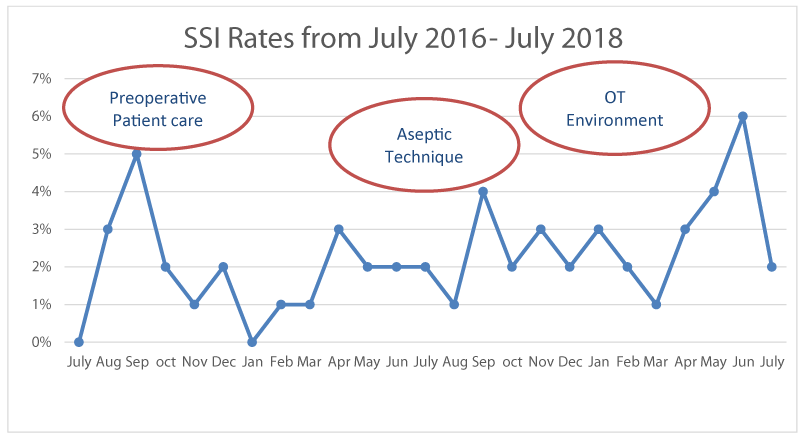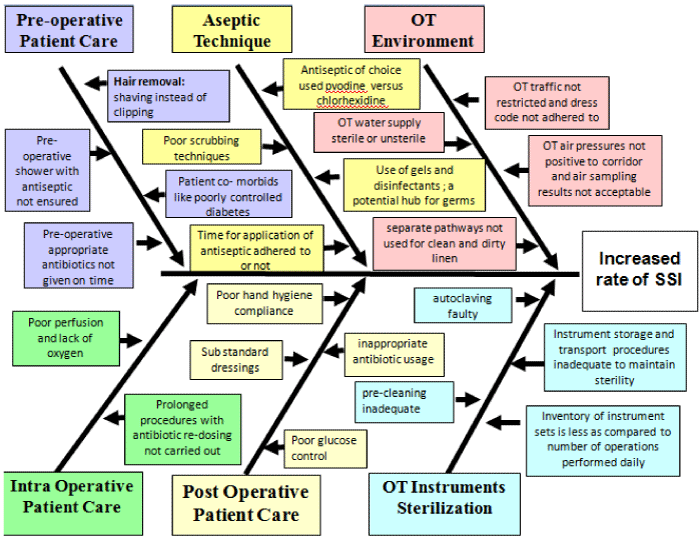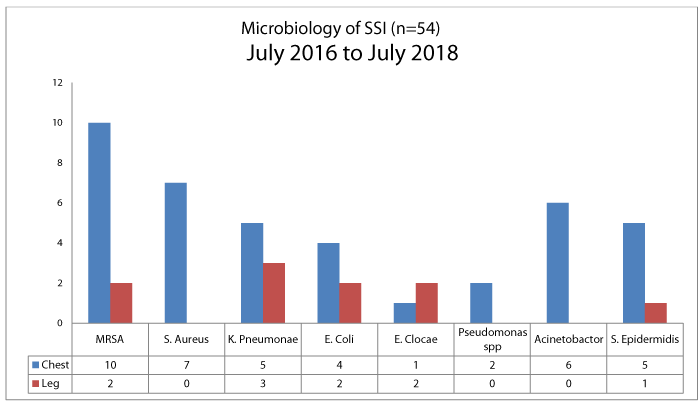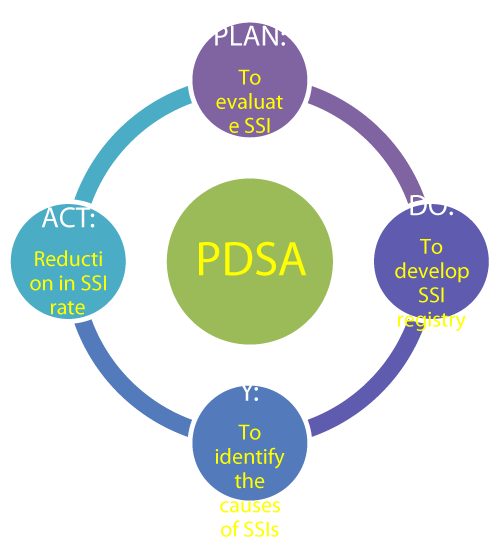Journal of Surgery and Surgical Research
Reducing surgical site infections through quality improvement initiative: A tertiary cardiac care facility experience in a developing country
Farrah Pervaiz1*, Safdar Abbas2, Imtiaz Ahmed Chaudhry3, Afsheen Iqbal4, Rehana Javaid5, Hafsa Khalil5 and Aysha Siddiqa5
2Executive Director P.A.F Hospital E-9, Islamabad, Pakistan
3Consultant Cardiac Surgeon, Army Cardiac Centre, Lahore, Pakistan
4Consultant cardiac surgeon, Armed Forces Institute of Cardiology & National Institute of Heart Diseases, Rawalpindi, Pakistan
5Research Officer, Research & Development Department, Armed Forces Institute of Cardiology & National Institute of Heart Diseases, Rawalpindi, Pakistan
Cite this as
Pervaiz F, Abbas S, Chaudhry IA, Iqbal A, Javaid R, et al. (2018) Reducing surgical site infections through quality improvement initiative: A tertiary cardiac care facility experience in a developing country. J Surg Surgical Res 4(2): 010-014. DOI: 10.17352/2455-2968.000052Introduction: Amongst healthcare associated infections (HAIs), surgical site infections (SSIs) are a preventable cause of increased morbidity and mortality and are associated with substantial financial costs. SSI rates are an indicator of the quality of surgical and postoperative care, which necessitates the need for robust surveillance systems for these healthcare associated infections. Patients undergoing coronary artery bypass grafting (CABG) are at a greater risk for infection due to their relatively older age and the presence of comorbid conditions like diabetes mellitus and obesity.
Objective: To establish the adult cardiothoracic surgical site infections registry to determine adult surgical site infection (SSI) rates and study impact of quality improvement initiatives on SSI rates.
Methods: The Adult Cardiothoracic SSI registry was developed at Armed Forces Institute of Cardiology and National Institute of Heart Disease, Rawalpindi, Pakistan. Monthly SSI rates were monitored for both CABG and Valvular heart surgeries inclusive of chest and leg SSIs instituted to control the increased SSI rate in September 2016 after a multidisciplinary approach.
Results: A total number of 2640 cardiac surgeries were carried out and the cumulative SSI rate was 2.0% (54) for a period of two year i.e. July 2016 to July 2018. The SSI rate for chest infections was 19.0% (10) and for leg wound (harvest site) infections was 81.0% (44). There was an increase in SSI rate 5% (04) during September 2016. After process improvements the rate declined to 1% in October 2016 and has remained less than or equal to 2% as of July 2018.
Conclusion: A high SSI rate was investigated and multi-modal process improvements and infection control measures were implemented, leading to a decrease in SSI rate from 4.0% to 2.0%.
Introduction
Amongst healthcare associated infections (HAIs), surgical site infections (SSIs) are a preventable cause of increased morbidity and mortality and are associated with substantial financial costs [1]. In spite of the great progress in surgical techniques, antimicrobial prophylaxis, environmental improvements in operating rooms, and effective infection prevention strategies and guidelines, surgical site infections (SSIs) remain one of the most frequent cause of health care associated infections (HAIs) [2,3]. Surgical Site Infection (SSI) is defined as an infection related to the cardiothoracic surgery and which occurred at or near the surgical incision inclusive of within 30 days of that operative procedure. According to the proposed Centers for Disease Control and Prevention (CDC) classification, infection of surgical wounds of sternotomies was considered as superficial if only the skin and subcutaneous tissue was involved; deep, when the infection reached the sternum but did not involve it and as organ or space infections when sternal osteomyelitis or mediastinitis occurred [4,5]. SSI rates are an indicator of the quality of surgical and postoperative care, which necessitates the need for robust surveillance systems for these healthcare associated infections [1,4]. In cardiac surgery, mediastinitis is a severe SSI often warranting surgical redo. Patients undergoing coronary artery bypass grafting (CABG) are at a greater risk for infection due to their relatively older age and the presence of comorbid conditions like Diabetes mellitus and obesity [6].
The SSIs are responsible for a bigger economic burden to healthcare systems in terms of added postoperative hospital period and expenditure [7]. Patients with an SSI have a 2-11 times higher risk of mortality as compared with operative patients without an SSI [8]. It is intricate to ignore the burden posed by surgical site infections (SSIs) on patients’ safety in terms of pain, suffering, delayed wound healing, increased use of antibiotics and antibiotic resistance, revision surgery, increased length of hospital stay, mortality, morbidity and excess healthcare costs [2,9].
Surgical care is an integral part of health care throughout the world, with an estimated 234 million operations performed annually. However, surgical care is also associated with a considerable risk of complications and death. Limited data, often of low quality are available from low- and middle-income countries on the prevalence of HAIs [10]. SSIs are the most common healthcare-associated infection, accounting for 31% of all HAIs among hospitalized patients. The CDC healthcare-associated infection (HAI) prevalence survey found that there were an estimated 157,500 surgical site infections associated with inpatient surgeries in 2013 [10-12]. National Health Care Safety Network (NHSN) data for 2006-2008 (16,147 SSIs following 849,659 operative procedures) showed an overall SSI rate of 1.9%. SSI is associated with a mortality rate of 3%, and 75% of SSI-associated deaths are directly attributable to the SSI [11,12]. However, recent analysis by WHO found that health care-associated infections are more frequent in resource-limited settings than in developed countries. At any given time, the prevalence of health care-associated infection varies between 5.7% and 19.1% in low- and middle-income countries 13. With the higher incidence of SSIs, the SSI rates have been reported to range from 2.5% to 41.9% with higher rates in developing countries. Besides, the surgical mortality in developing nations is 10 times higher than developed countries and deaths attributed to anesthesia are 1000-fold higher [7,9]. In a recent meta-analysis report of 220 international studies investigating SSIs rates in developing countries, the cumulative incidence ranged from 0.4 to 30.9 per 100 patients and from 1.2 to 23.6 per 100 surgical procedures, while the pooled cumulative incidence was 11.8 per 100 patients [8,13].
Several studies have identified the main patient-related (endogenous) and procedure-related (external) factors that influence the risk of SSI. Potential patient-related factors include malnutrition, older age, coexistent infection, and diabetes. A review article showed that in the hierarchy of patient-related risk factors, serum albumin concentration and advanced age rank at the top of the list [14]. Surgical risk factors include the type and duration of operation, surgeon’s skill, and quality of preoperative skin preparation, adequacy and timing of prophylaxis, insertion of foreign material or implants, inadequate sterilization of surgical instruments. The rate of surgical wound infections is strongly influenced by operating theatre quality, too [15].
The pathogens isolated from infections differ, primarily depending on the type of surgical procedure. In clean surgical procedures, in which the gastrointestinal, gynecologic, and respiratory tracts have not been entered, Staphylococcus aureus from the patient’s skin flora is the usual cause of infection. When mucous membranes or skin is incised, the exposed tissues are at risk of contamination by endogenous flora [6]. Approximately 20 to 30% of surgical-site infections are caused by S. Aureus, and over half of these arise from the endogenous flora. Occasionally, the pathogenic microorganisms are acquired from an exogenous source, such as the operating theatre environment, surgical personnel and all tools, instruments, and materials brought to the sterile field during an operation. The most commonly isolated organisms are Staphylococcus aureus, coagulase-negative staphylococci, Enterococcus spp. and Escherichia coli [16]. Over the last decade, there has been little variation in the incidence and distribution of the pathogens isolated from infections [16,17], however, an important change in the microbiology of SSIs has been the increasing involvement of microorganisms that are resistant to antibiotic treatment. Indeed, the number of SSIs caused by methicillin-resistant S. Aureus (MRSA) has increased dramatically [17].
Quality improvement measures for reducing SSIs included infection control measures such as adequate patient skin asepsis, pre-operative prophylactic antibiotics; strict glycemic control and surveillance of SSI rates for feedback to the surgeons [16]. Improvement of health care requires making changes in processes of care and service delivery [7,15]. The key to identifying beneficial change is measurement. The major components of measurement include: (1) determining and defining key indicators; (2) collecting an appropriate amount of data; and (3) analyzing and interpreting these data [4,15]. This paper focuses on the third component—the analysis and interpretation of data—using statistical process control (SPC). SPC charts can help both researchers and practitioners of quality improvement to determine whether changes in processes are making a real difference in outcomes. We developed the adult Cardiothoracic SSI registry for surveillance purposes, which is an ongoing registry in tandem with Plan-Do-Check-Act (PDCA) cycle for reducing our center’s SSI rates.
Methodology
The adult Cardiothoracic SSI registry was developed in a 250 bedded tertiary Cardiac care teaching hospital. About 25 heart surgeries are being performed by the Adult Heart Surgery Unit of our hospital per week. The study population comprised of all patients who had undergone cardiac surgery between July 2016 and July 2018. The inclusion criteria comprised of patients with aged >18 years, having undergone cardiac surgery through longitudinal median sternotomy; inclusive of both coronary artery bypass grafting (CABG) and those patients who had undergone valve repair or replacement.
Although this is an ongoing registry, for the purpose of this analysis the 30 day period for surveillance was used, however the patients who present post discharge within 90 days post procedure with deep infections or mediastinitis are being included in this registry. All procedures included in the monthly surveillance plan are being followed for superficial, deep, and organ space (mediastinitis) SSIs [9]. The methodology being used includes direct examination of patient’s wounds during follow-up visits to adult cardiothoracic surgery outpatients’ department, patient readmissions and review of medical records. We are using a specially designed data collection tool adapted from the Association of Practitioners in Infection Control (APIC) which includes patient demographics, type of cardiothoracic surgical procedure, type of SSI and SSI culture reports [18].
Fishbone diagram procedure
The fishbone diagram identifies many possible causes for an effect or problem. It can be used to structure a brainstorming session. It immediately sorts ideas into useful categories [19]. For improving the SSI rates after September 2016, the problem statement (effect) outlined was the increased rate of surgical site infections for Cardiopulmonary Bypass Surgery from a baseline of 1% to 6% (Figure 1). Brainstorming for the major categories of causes of the problem was carried out by a multidisciplinary team the Infection Control Committee and possible various causes were outlined as figure 2.
Preoperative patient preparation inclusive of hair removal, antiseptic body washes, skin asepsis, prophylactic antibiotic administration, operating room practices, surgical technique, evaluated causative microorganisms, post -operative care inclusive of glycemic control, surgical dressings were reassessed.
PDSA cycle
Identifying SSIs is multidimensional, as a strategy to reduce SSIs and as a part of Surveillance we developed Adult Cardiothoracic SSI registry to collect appropriate data and provide useful feedback to the surgeons. The model for improvement has Three fundamental questions that guide improvement teams to set clear aims, establish measures that will tell if changes are leading to improvement, and to identify changes that are likely to lead to improvement.
As a part of quality improvement initiative and surveillance for reducing SSI we applied PDSA cycle to conduct small-scale tests of change in real work settings by planning a test, trying it, observing the results, and acting on what is learned. This is the scientific method, used for action-oriented learning.
Statistical analysis
Data was entered in the Statistical Package for the Social Sciences (SPSS) version 23.0 for analysis. Numeric variables were analyzed as descriptive statistics, through measures of central tendency (mean and median) and variability (minimum, maximum and standard deviation). Surgical site infection rate was expressed as a percentage.
Results
A total of 2640 cardiothoracic procedures were carried out from 1st July 2016 to 31st July 2018, inclusive of 68.3% (1805) CABG procedures and 16.8% (446) valvular heart surgeries. The cumulative SSI rate was 2.0% (54) for this period. Chest infection rate was 19.0% (10) while leg wound infection rate was 81.0% (44). Amongst the patients who presented with SSIs 61.0% (33) were males and 39.0% (21) were females. The mean age of patients with SSIs was 55±12 years, the average BMI was 27±4.0 Kg/m2 (overweight category) and the average time to presentation was 21±9 days. There were 19.0% (10) chest site infections inclusive of 70.0% (38) superficial, 24.0% (13) deep and 6.0% (3) cases of mediastinitis. Gram negative bacteria were implicated in leg site infections and mostly staphylococci were implicated in chest SSIs as shown in figure 3. There was an increase in SSI rate in September 2016 of 4% (04) as shown in figure 1. After process improvements as outlined in figure 1, the SSI rate declined to 1% in October 2016 and has remained less than or equal to 2% as of July 2018.
Fishbone diagram helped us to identify the gaps in the domains of pre operative aseptic technique for patients and OT (Operation theatre) environment and helped us to apply process improvement measures in those respective areas to improve our critical domains. The important factors shown in figure 2 played significant role in reducing the SSI. We applied PDSA cycle, an action-oriented scientific method for reduction of SSI rates as shown in figure 4. In our study a prominent reduction in SSI rates was observed which was 4% and it was reduced to 2% in a time period of two years i.e. July 2016- July 2018.
Discussion
Surgical site infections (SSIs) following cardiac surgery can be life-threatening and devastating; every effort should be made to reduce their rate of occurrence. SSI rates are an indicator of the quality of surgical and postoperative care, which necessitates the need for robust surveillance systems for these healthcare associated infections [20].
The present study was conducted to investigate the high incidence of SSIs after open heart surgery and to define the efficacy of quality control tools in the prevention of hospital acquired infections at a tertiary cardiac care facility.
In our study 54 cases of surgical site infections were reported [chest 10(19%) and leg 44(81%)]. These findings are in line with Yavuz SS et al., who documents a high rate of SSIs can be decreased with proper infection control interventions [21]. We carried out process improvements encompassing the perioperative processes focusing on hand hygiene, skin asepsis and surgical scrub techniques and operation theatre environment. A.M. Spagnolo et al., states that the prevention of SSI requires a multidisciplinary approach and the commitment of all concerned, including that of those who are responsible for the design, layout and functioning of operating theatres [22].
Diabetes (33%) and smoking (7%) were important risk factors in our study population. These findings are confirmed by published literature documenting a trend between the sternal wound dehiscence and smoking (P = 0.03); however, the other sternal wound complications were not associated with smoking [23].
The most common pathogens isolated in our study were Methicilin Resistant Staph Aureus (MRSA), Methicilin Sensitive Staphylococcus aureus (MSSA) gram negative bacteria and coagulase negative staphylococci. This finding is in agreement with Si D et al., which indicated the importance of gram-negative organisms as causative agents for surgical site infections following CABG surgery [24].
There were some limitations associated with our study. We were not able to carry risk stratification as it’s an ongoing registry. Morikane et al., documented the incidence of SSI rates in CABG as 2.6% and for surgeries other than CABG as 4.1%. Published literature suggests a high American Society of Anesthesiologists (AHA) score and long duration of operation as important predictors of SSI risk in their model [25].
Our study clearly demonstrated that systematic collection of HAIs associated data on a routine basis can be utilized for SSI surveillance and can contribute towards quality improvement. King et al., created a syndromic surveillance for postoperative SSIs in CABG procedures utilizing data from local hospital information system and cardiac surgery registry with a cumulative SSI rate of 6.6% [26].
- De Lissovoy G, Fraeman K, Hutchins V, Murphy D, Song D, et al. (2009) Surgical site infection: incidence and impact on hospital utilization and treatment costs. Am J Infect Control 37: 387-397. Link: https://tinyurl.com/ybhul4rt
- Anderson DJ, Podgorny K, Berrios-Torres SI, Bratzler DW, Dellinger EP, et al. (2014) Strategies to Prevent Surgical Site Infections in Acute Care Hospitals 35: 66-88. Link: https://tinyurl.com/ybjrscoz
- Ozgediz D, Jamison D, Cherian M, McQueen K (2008) The burden of surgical conditions and access to surgical care in low-and middle-income countries. Bulletin of the World Health Organization 86: 646-647. Link: https://tinyurl.com/y87zrean
- Horan TC, Gaynes RP, Martone WJ, Jarvis WR, Emori TG (1992) CDC definitions of nosocomial surgical site infections, 1992: a modification of CDC definitions of surgical wound infections. Infect Control Hosp Epidemiol 13: 606-608. Link: https://tinyurl.com/y84drbjp
- Mangram AJ, Horan TC, Pearson ML, Silver LC, Jarvis WR (1999) Guideline for prevention of surgical site infection, 1999. Hospital Infection Control Practices Advisory Committee. Infect Control HospEpidemiol 20: 247-278. Link: https://tinyurl.com/ya2ak9ny
- Fowler VG Jr, O'Brien SM, Muhlbaier LH, Corey GR, Ferguson TB (2005) Clinical predictors of major infections after cardiac surgery. Circulation 112: 358–365. Link: https://tinyurl.com/ycohj4dz
- World Health Organization (2016) Report on the burden of endemic health careassociated infection worldwide: clean care is safer care. World Health Organization
- Allegranzi B, Bagheri Nejad S, Combescure C, Graafmans W, Attar H, et al. (2010) Burden of endemic health-care-associated infection in developing countries: systematic review and meta-analysis. Lancet 377: 228-241. Link: https://tinyurl.com/ycuqw7t3
- Horan TC, Andrus M, Dudeck MA (2008) CDC/NHSN surveillance definition of health care–associated infection and criteria for specific types of infections in the acute care setting. American journal of infection control 36: 309-332. Link: https://tinyurl.com/y74m7h6c
- Lloyd-Jones D, Adams RJ, Brown TM, Carnethon M, Dai S, et al. (2009) Heart disease and stroke statistics—2010 update. Circulation, 121: 46-215. Link: https://tinyurl.com/ybptxabl
- Magill SS, Hellinger W, Cohen J, Kay R, Bailey C, et al. (2012) "Prevalence of healthcare-associated infections in acute care hospitals in Jacksonville, Florida". Infection Control Hospital Epidemiology 33: 283-291. Link: https://tinyurl.com/yd8278gl
- Magill SS, Edwards JR, Bamberg W, Beldavs ZG, Dumyati G, et al. (2014) "Multistate point-prevalence survey of health care-associated infections". New England Journal of Medicine 370: 1198-208. Link: https://tinyurl.com/y7yjwkfd
- (2002) World Health Organization. The world health report 2002: reducing risks, promoting healthy life. World Health Organization. WHO (World Health Organization). Link: https://tinyurl.com/9kkczuw
- Spagnolo AM, Ottria G, Amicizia D, Perdelli F, Cristina ML (2013) Operating theatre quality and prevention of surgical site infections. Journal of preventive medicine and hygiene 54: 131. Link: https://tinyurl.com/y7hrj9sx
- Odom-Forren J (2006) Preventing surgical site infections 36: 59-63. Link: https://tinyurl.com/y6u4z593
- Dua A, Desai SS, Seabrook GR, Brown KR, Lewis BD, et al. (2014) The effect of Surgical Care Improvement Project measures on national trends on surgical site infections in open vascular procedures.J Vasc Surg 60: 1635-1639. Link: https://tinyurl.com/y8gtrugd
- Stulberg JJ, Delaney CP, Neuhauser DV, Aron DC, Fu P, et al. (2010) Adherence to surgical care improvement project measures and the association with postoperative infections. Jama 303: 2479-2485. Link: https://tinyurl.com/y7wu8vp6
- An APIC Guide (2008) Guide for the Prevention of Mediastinitis Surgical Site Infections Following Cardiac Surgery. Link: https://tinyurl.com/y9e3pac2
- Nancy R, Tague (2004) The Quality Toolbox, Second Edition, ASQ Quality Press 247–249. Link: https://tinyurl.com/y9wlxsgy
- Koek MB, Wille JC, Isken MR, Voss A, van Benthem BH (2015) Postdischarge surveillance (PDS) for surgical site infections: a good method is more important than a long duration. Euro Surveill 20: 21042. Link: https://tinyurl.com/y7zrkrfp
- Yavuz SŞ, Tarçın O, Ada S, Dinçer F, Toraman S, et al. (2013) Incidence, aetiology, and control of sternal surgical l site infections. J Hosp Infect 85: 206-212. Link: https://tinyurl.com/yc5vyhgp
- Spagnolo AM, Ottria G, Amicizia D, Perdelli F, Cristina Ml (2013) Operating theatre quality and prevention of surgical site infections. J Prev Med Hyg 54: 131–137. Link: https://tinyurl.com/y8aaejom
- Sharif-Kashani B, Shahabi P, Mandegar MH, Saliminejad L, Bikdeli B, et al. (2016) Smoking and wound complications after coronary artery bypass grafting. J Surg Res 200: 743-748. Link: https://tinyurl.com/y7l3etfz
- Si D, Rajmokan M, Lakhan P, Marquess J, Coulter C, et al. (2014) Surgical site infections following coronary artery bypass graft procedures: 10 years of surveillance data. BMC Infect Dis. Link: https://tinyurl.com/ya39howc
- Morikane K, Honda H, Yamagishi T, Suzuki S (2015) Differences in risk factors associated with surgical site infections following two types of cardiac surgery in Japanese patients. J Hosp Infect 90: 15-21. Link: https://tinyurl.com/y73rjzgh
- King C, Aylin P, Moore LS, Pavlu J, Holmes A (2014) Syndromic surveillance of surgical site infections--a case study in coronary artery bypass graft patients. J Infect 68: 23-31. Link: https://tinyurl.com/y9qyb3g9
- Hyder AA, Rotllant G, Morrow RH (1998) Measuring the burden of disease: healthy life-years. American Journal of Public Health 88: 196-202. Link: https://tinyurl.com/y78ndfva
Article Alerts
Subscribe to our articles alerts and stay tuned.
 This work is licensed under a Creative Commons Attribution 4.0 International License.
This work is licensed under a Creative Commons Attribution 4.0 International License.





 Save to Mendeley
Save to Mendeley
